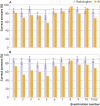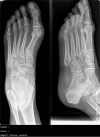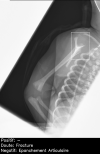Can artificial intelligence pass the Fellowship of the Royal College of Radiologists examination? Multi-reader diagnostic accuracy study
- PMID: 36543352
- PMCID: PMC9768816
- DOI: 10.1136/bmj-2022-072826
Can artificial intelligence pass the Fellowship of the Royal College of Radiologists examination? Multi-reader diagnostic accuracy study
Abstract
Objective: To determine whether an artificial intelligence candidate could pass the rapid (radiographic) reporting component of the Fellowship of the Royal College of Radiologists (FRCR) examination.
Design: Prospective multi-reader diagnostic accuracy study.
Setting: United Kingdom.
Participants: One artificial intelligence candidate (Smarturgences, Milvue) and 26 radiologists who had passed the FRCR examination in the preceding 12 months.
Main outcome measures: Accuracy and pass rate of the artificial intelligence compared with radiologists across 10 mock FRCR rapid reporting examinations (each examination containing 30 radiographs, requiring 90% accuracy rate to pass).
Results: When non-interpretable images were excluded from the analysis, the artificial intelligence candidate achieved an average overall accuracy of 79.5% (95% confidence interval 74.1% to 84.3%) and passed two of 10 mock FRCR examinations. The average radiologist achieved an average accuracy of 84.8% (76.1-91.9%) and passed four of 10 mock examinations. The sensitivity for the artificial intelligence was 83.6% (95% confidence interval 76.2% to 89.4%) and the specificity was 75.2% (66.7% to 82.5%), compared with summary estimates across all radiologists of 84.1% (81.0% to 87.0%) and 87.3% (85.0% to 89.3%). Across 148/300 radiographs that were correctly interpreted by >90% of radiologists, the artificial intelligence candidate was incorrect in 14/148 (9%). In 20/300 radiographs that most (>50%) radiologists interpreted incorrectly, the artificial intelligence candidate was correct in 10/20 (50%). Most imaging pitfalls related to interpretation of musculoskeletal rather than chest radiographs.
Conclusions: When special dispensation for the artificial intelligence candidate was provided (that is, exclusion of non-interpretable images), the artificial intelligence candidate was able to pass two of 10 mock examinations. Potential exists for the artificial intelligence candidate to improve its radiographic interpretation skills by focusing on musculoskeletal cases and learning to interpret radiographs of the axial skeleton and abdomen that are currently considered "non-interpretable."
© Author(s) (or their employer(s)) 2019. Re-use permitted under CC BY. No commercial re-use. See rights and permissions. Published by BMJ.
Conflict of interest statement
Competing interests: All authors have completed the ICJME uniform disclosure form at https://www.icmje.org/disclosure-of-interest/ and declare: support from the National Institute for Health Research; no financial relationships with any organisations that might have an interest in the submitted work in the previous three years; SS is the organiser of a radiology revision course mentioned in this study and helped to recruit radiologist readers to the project, but this relationship had no influence on the reported results of the work and no financial incentive was provided; no other relationships or activities that could appear to have influenced the submitted work.
Figures







Comment in
-
Beyond the AJR: Comparison of Artificial Intelligence Candidate and Radiologists on Mock Examinations for the Fellow of Royal College of Radiology Part B.AJR Am J Roentgenol. 2023 Oct;221(4):555. doi: 10.2214/AJR.23.29155. Epub 2023 Mar 1. AJR Am J Roentgenol. 2023. PMID: 36856302 No abstract available.
References
-
- Mukherjee S. A.I. versus M.D: What happens when diagnosis is automated? 2017. https://www.newyorker.com/magazine/2017/04/03/ai-versus-md.
-
- The Royal College of Radiologists. Final Examination for the Fellowship in Clinical Radiology (Part B) Scoring System. https://www.rcr.ac.uk/sites/default/files/docs/radiology/pdf/CR2B_scorin....
-
- The Royal College of Radiologists. FRCR Part 2B (Radiology) - CR2B Examination Information. 2022. https://www.rcr.ac.uk/clinical-radiology/examinations/frcr-part-2b-radio....
MeSH terms
LinkOut - more resources
Full Text Sources
